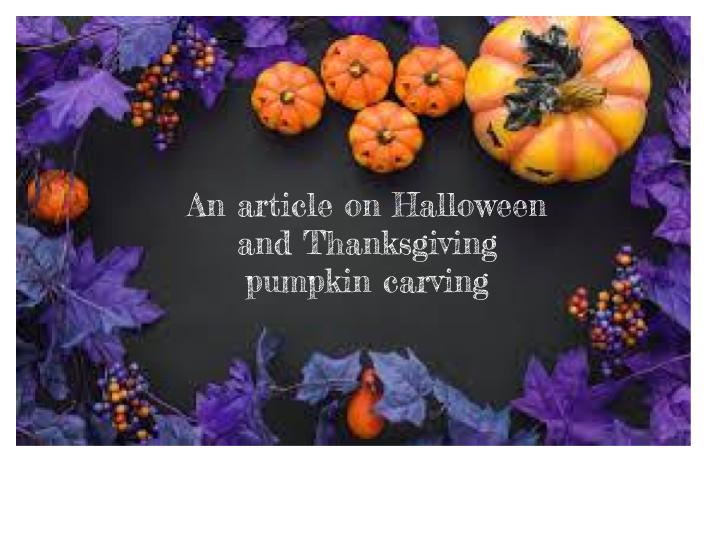With Halloween behind us and Thanksgiving just around the corner, many people set out carved pumpkins on their doorstep oblivious to their deep connection to the devil and Irish folklore.
-Chiara Kovac, 7th grade
With Halloween behind us and Thanksgiving just around the corner, many people set out carved pumpkins on their doorstep oblivious to their deep connection to the devil and Irish folklore.
In ancient Celtic lore, during the three-day pagan holiday of Samhain, the barrier from the land of the living and the land of the dead was very thin, and ghosts could pass into our world. When Christianity was introduced to Ireland, the three days where rolled into one.
On Hallows Eve, the Irish would carve pumpkins to represent and remind the people of an old tale. Well, not exactly. There were no pumpkins in Ireland so instead they would carve turnips, rutabaga and potatoes. When the Irish came to America bringing their traditions with them, they traded turnips for pumpkins seeing as they were cheaper and easier to carve.
This is the story of Stingy Jack according to History.com:
Jack was an alcoholic who tricked Satan several times. The second time he tricked him, Jack made the Devil promise to never take him to Hell. When Jack died, he was denied from both realms (Heaven and Hell) and forced to walk the pathway between them for all eternity. Satan gave him a carved turnip and a candle to guide his way. That vegetable lantern was all Jack had and he held onto it, making himself known as Jack of the Lantern. Or simply Jack-o-Lantern, henceforth the jack-o-lantern. Irish children would leave their gourd lanterns on doorsteps and window sills to ward Jack away.
According to Celtic Thunder, the word pumpkin was originally a Greek word, pepon meaning large melon. It was later changed to pompon by the french and then pumpion by the English. The colonists changed it to pumpkin. There have been several references to pumpkins in literature such as Cinderella, the Legends of Sleepy Hollow and even Shakespeare's work.
Native Americans also used pumpkins and wove dried pumpkin skin into mats. They would eat long roasted strips of pumpkin flesh. When the colonists came they made the first pumpkin pie by removing the pumpkin’s insides and replacing it with milk, spices and honey before baking the pumpkin in ashes.
Sources:
https://www.celticthunder.com/blog/2016/10/02/history-jack-o-lantern/
https://www.history.com/news/history-of-the-jack-o-lantern-irish-origins
In ancient Celtic lore, during the three-day pagan holiday of Samhain, the barrier from the land of the living and the land of the dead was very thin, and ghosts could pass into our world. When Christianity was introduced to Ireland, the three days where rolled into one.
On Hallows Eve, the Irish would carve pumpkins to represent and remind the people of an old tale. Well, not exactly. There were no pumpkins in Ireland so instead they would carve turnips, rutabaga and potatoes. When the Irish came to America bringing their traditions with them, they traded turnips for pumpkins seeing as they were cheaper and easier to carve.
This is the story of Stingy Jack according to History.com:
Jack was an alcoholic who tricked Satan several times. The second time he tricked him, Jack made the Devil promise to never take him to Hell. When Jack died, he was denied from both realms (Heaven and Hell) and forced to walk the pathway between them for all eternity. Satan gave him a carved turnip and a candle to guide his way. That vegetable lantern was all Jack had and he held onto it, making himself known as Jack of the Lantern. Or simply Jack-o-Lantern, henceforth the jack-o-lantern. Irish children would leave their gourd lanterns on doorsteps and window sills to ward Jack away.
According to Celtic Thunder, the word pumpkin was originally a Greek word, pepon meaning large melon. It was later changed to pompon by the french and then pumpion by the English. The colonists changed it to pumpkin. There have been several references to pumpkins in literature such as Cinderella, the Legends of Sleepy Hollow and even Shakespeare's work.
Native Americans also used pumpkins and wove dried pumpkin skin into mats. They would eat long roasted strips of pumpkin flesh. When the colonists came they made the first pumpkin pie by removing the pumpkin’s insides and replacing it with milk, spices and honey before baking the pumpkin in ashes.
Sources:
https://www.celticthunder.com/blog/2016/10/02/history-jack-o-lantern/
https://www.history.com/news/history-of-the-jack-o-lantern-irish-origins


